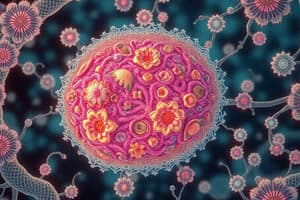Podcast
Questions and Answers
What is the control center of the cell?
What is the control center of the cell?
Nucleus
Which of the following are structural elements in eukaryotic cells? (Select all that apply)
Which of the following are structural elements in eukaryotic cells? (Select all that apply)
- Flagella (correct)
- Cell wall (correct)
- Plasma membrane
- Cytoskeleton (correct)
What is the function of the cell wall?
What is the function of the cell wall?
Protect and support
What is the function of the cytoskeleton?
What is the function of the cytoskeleton?
What is the function of flagella and cilia?
What is the function of flagella and cilia?
What are the components of the plasma membrane?
What are the components of the plasma membrane?
What is the main function of the endoplasmic reticulum?
What is the main function of the endoplasmic reticulum?
What distinguishes rough endoplasmic reticulum from smooth endoplasmic reticulum?
What distinguishes rough endoplasmic reticulum from smooth endoplasmic reticulum?
What is the main role of the Golgi complex?
What is the main role of the Golgi complex?
Lysosomes function to digest worn-out organelles and cell debris, playing a role in _____
Lysosomes function to digest worn-out organelles and cell debris, playing a role in _____
Which organelles are known as energy-producing organelles?
Which organelles are known as energy-producing organelles?
What is the function of mitochondria?
What is the function of mitochondria?
What is the main function of chloroplasts?
What is the main function of chloroplasts?
What is the structure of chromosomes?
What is the structure of chromosomes?
What is the role of the nucleolus?
What is the role of the nucleolus?
What is the function of ribosomes?
What is the function of ribosomes?
The nuclear envelope isolates the nucleus with _____ membranes.
The nuclear envelope isolates the nucleus with _____ membranes.
What is the purpose of nuclear pores?
What is the purpose of nuclear pores?
What type of DNA is found in prokaryotes compared to eukaryotes?
What type of DNA is found in prokaryotes compared to eukaryotes?
Flashcards are hidden until you start studying
Study Notes
Nucleus
- The nucleus functions as the control center of eukaryotic cells, directing cellular activities and storing genetic information.
- Enclosed by a double membrane, the nuclear envelope separates the nucleus from the cytoplasm.
Structural Elements in Eukaryotic Cells
- Key components include the cell wall, cytoskeleton, flagella, and cilia, contributing to overall cell structure and function.
Cell Wall
- Composed of cellulose or chitin, the cell wall provides protection and support, absent in animal cells.
Cytoskeleton
- A network of protein filaments that offers structural support and facilitates cell movement.
Flagella and Cilia
- Cellular extensions characterized by a 9+2 arrangement of microtubules, primarily facilitating motility and the movement of fluids.
Plasma Membrane
- A lipid bilayer embedded with proteins, regulating the entry and exit of substances and enabling cell recognition.
Endoplasmic Reticulum (ER)
- Internal membrane network classified into rough ER, which synthesizes proteins, and smooth ER, specializing in lipid synthesis and detoxification.
Golgi Complex
- Stacks of flattened vesicles function as the cell's "post office," packaging proteins for export and processing materials for transport.
Lysosomes
- Vesicles containing hydrolytic enzymes, responsible for digesting worn-out organelles, cell debris, and facilitating cell death.
Energy-Producing Organelles
- Mitochondria and chloroplasts are responsible for cellular respiration and photosynthesis, respectively.
Mitochondria
- Double-membraned organelles involved in oxidative metabolism, providing ATP as an energy source for cellular functions.
Chloroplast
- Organelles in plants and algae with a complex inner membrane structure, essential for photosynthesis.
Organelles of Genetic Expression
- Key components include chromosomes, nucleoli, and ribosomes, playing vital roles in gene expression and protein synthesis.
Chromosomes
- Long DNA threads complexed with proteins carrying hereditary information, essential during cell division.
Nucleolus
- The site within the nucleus for ribosomal RNA (rRNA) synthesis and ribosome assembly.
Ribosomes
- Composed of protein and rRNA, ribosomes are essential for translating RNA into proteins, found either free in the cytoplasm or attached to rough ER.
Nuclear Envelope
- A dual membrane structure isolating the nucleus, featuring nuclear pores for selective material exchange with the cytoplasm.
Nuclear Pores
- Openings formed by the fusion of nuclear envelope membranes, controlling access and facilitating the movement of proteins and RNA in and out of the nucleus.
Nucleoplasm and Chromatin
- The nucleoplasm contains chromatin, the complex of DNA and proteins, which uncoils during cell division to allow for protein synthesis.
Protein Synthesis
- RNA is transcribed from DNA in the nucleus, leaving through nuclear pores to direct protein assembly in the cytoplasm.
Differences between Prokaryotes and Eukaryotes
- Prokaryotic DNA exists as an enclosed circle, while eukaryotic DNA is segmented into chromosomes associated with proteins, underpinning structural and functional differences.
Studying That Suits You
Use AI to generate personalized quizzes and flashcards to suit your learning preferences.




